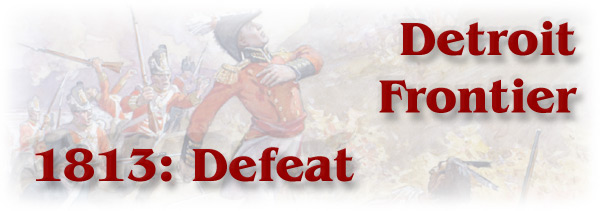
Table of Contents
Home | Setting the Stage | Battlegrounds | Militia and Civilian Life
Prisoners of War | Loyalty and Treason | The War Ends
After the War | Chronology | Soldiering in Canada
Important Figures | Important Places| Glossary
Sources | Links | The Making of a Virtual Exhibit
As a result, the vessels built on the upper lakes were much smaller and more lightly armed. This did not prevent the main naval battle of the war in Upper Canada at Put-in Bay, from being a bloody and hard-fought engagement. |
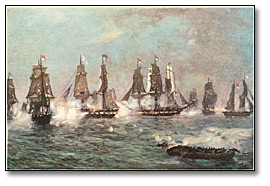 Click
to see a larger image (126K) |
|
|
|
||
|
Lieutenant Barclay commanded the British squadron which was outgunned and outmanned by the American squadron under Commodore Perry. Many of the guns on the British vessels had been taken from the walls of Forts Malden and Detroit, as those originally intended for the squadron had been lost earlier in the year when the Americans captured York. The situation in the western part of the province, never good for the British, was taken to the breaking point by this defeat.
|
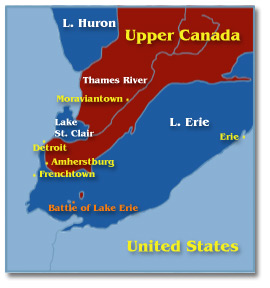 |
|
|
||
|
||
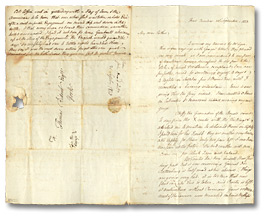 Click
to see a larger image (222K) |
||
|
Letter from
Thomas G. Ridout to his father Thomas Ridout, September 21, 1813 |
||
|
The capture of the British
squadron exposed General Proctor’s position at Detroit and
seriously interfered with the shipment of supplies to British garrisons
and First Nations in the north-west. This led to the evacuation
of Detroit and the retreat that ended with Proctor's defeat and
Tecumseh's death at
Moraviantown. |
||
| [ Return to top
of page ] |
||
 |
||
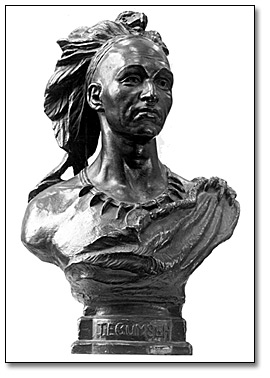
|
The death of Tecumseh at the Battle of Moraviantown (Battle of the Thames) rivalled Brock’s as a symbol of Upper Canadian patriotism after the war. It also marked the beginning of the end of the long alliance between the British Crown and the First Nations resident in the United States. Portrait Bust of Tecumseh, 1896 |
|
When the final peace treaty was signed in 1814, the British were unable to get the Americans to agree to guarantees previously promised by Upper Canada to the First Nations people. These promises were aimed at protecting First Nations land from American settlement. The failure of the British to achieve these guarantees jeopardized future alliances. Tens-Kwau-Ta-Waw, The Prophet, was Tecumseh's half brother and was active in organizing the First Nations against the Americans. Click
to see a larger image (661K) |
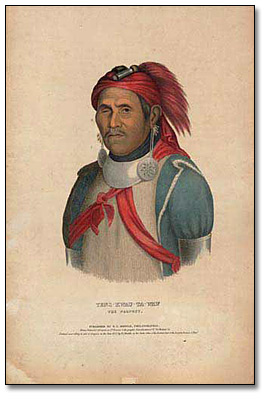
|
|
| [ Return to top
of page ] |
||
 |
||
|
|
||
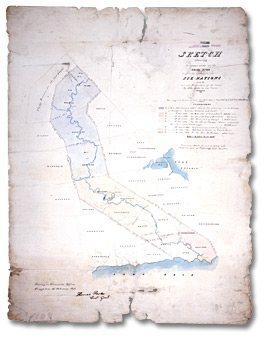
|
There were attempts to interfere with American raids by sending patrols into the region. One met with defeat at the Battle of the Long Woods, March 4, 1814, another under Colonel Bostwick succeeded in capturing a number of Canadians assisting the invaders, many of whom were brought to Ancaster for the Treason trials in 1814.
Click
to see a larger image (417K) |
|
| [ Return to top
of page ] |
||

 he
naval forces on the Upper Lakes (Erie
and Huron) were subordinate commands to the main forces
on Lake Ontario. Both sides faced communications
and supply problems in the less heavily settled Lake Erie region
and neither the Welland nor Erie Canals then existed to facilitate
the movement of supplies.
he
naval forces on the Upper Lakes (Erie
and Huron) were subordinate commands to the main forces
on Lake Ontario. Both sides faced communications
and supply problems in the less heavily settled Lake Erie region
and neither the Welland nor Erie Canals then existed to facilitate
the movement of supplies. 
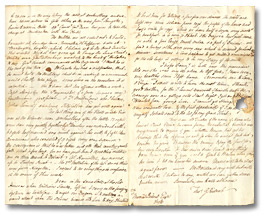
 efore
the war Tecumseh and his half-brother
efore
the war Tecumseh and his half-brother